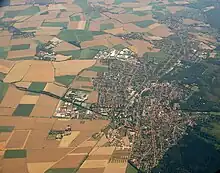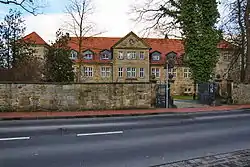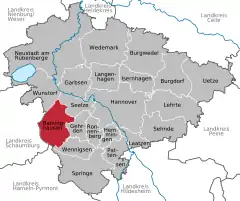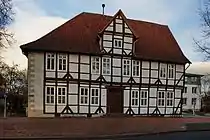Barsinghausen
Barsinghausen is a town in the district of Hanover, in Lower Saxony, Germany. It is situated at the Deister chain of hills approx. 20 km west of Hanover. Barsinghausen belongs to the historic landscape Calenberg Land and was first mentioned in 1193.


Barsinghausen | |
|---|---|
 Barsinghausen Monastery | |
 Coat of arms | |
Location of Barsinghausen within Hanover district  | |
 Barsinghausen  Barsinghausen | |
| Coordinates: 52°18′0″N 9°28′52″E | |
| Country | Germany |
| State | Lower Saxony |
| District | Hanover |
| Subdivisions | 18 district |
| Government | |
| • Mayor (2020–25) | Henning Schünhof[1] (SPD) |
| Area | |
| • Total | 102.65 km2 (39.63 sq mi) |
| Elevation | 142 m (466 ft) |
| Population (2021-12-31)[2] | |
| • Total | 34,327 |
| • Density | 330/km2 (870/sq mi) |
| Time zone | UTC+01:00 (CET) |
| • Summer (DST) | UTC+02:00 (CEST) |
| Postal codes | 30890 |
| Dialling codes | 05105 |
| Vehicle registration | H |
| Website | www.barsinghausen.de |
Geography
Neighbouring places
Barsinghausen adjoins Wunstorf, Seelze, Gehrden, Springe, Bad Nenndorf and Wennigsen.

Division of the town
Barsinghausen consists of 18 districts: Bantorf, Barrigsen, Barsinghausen, Eckerde, Egestorf, Göxe, Großgoltern, Nordgoltern, Groß Munzel, Hohenbostel, Holtensen, Kirchdorf, Landringhausen, Langreder, Ostermunzel, Stemmen, Wichtringhausen, Winninghausen
History
Barsinghausen is the site of an old double monastery (“Kloster Barsinghausen”) that was established during the High Middle Ages. At that time, fertile loess soil and a number of influent streams to river Südaue constituted a central fundament for farming and numerous windmills in Calenberg Land. Barsinghausen became a coal mining town between 1871 and 1957. After World War II, other sectors of industry began to dominate Barsinghausen's economy.
Population development
(each time at 31 December)
- 1998 – 34,743
- 1999 – 34,648
- 2000 – 34,497
- 2001 – 34,408
- 2002 – 34,370
- 2003 – 34,376
- 2004 – 34,253
Sights
Barsinghausen is home to "Kloster Barsinghausen", a nunnery first mentioned in 1193 (now a Lutheran women's convent, to Monastery Church St. Mary ("Marienkirche"), to the Deister Open Air Theater (“Deister Freilichtbühne”), to the exhibition mine “Klosterstollen”, to Sport Hotel Fuchsbachtal and to Lower Saxony's Soccer Association. The Colossus of Ostermunzel is a glacial erratic qualified as a natural monument.[3] Its large size is abnormal, particularly for northern Germany and especially for Lower Saxony.[4]
Education
Elementary schools
- Adolf-Grimme-Schule
- Wilhelm-Stedler-Schule
- Ernst-Reuter-Schule
- Astrid-Lindgren-Schule
- Albert-Schweitzer-Schule
- Grundschule Groß Munzel
- Grundschule Hohenbostel
- Grundschule Bantorf
Secondary schools
Special schools
- Bert-Brecht-Schule (Special education school)
- VHS (Volkshochschule – Adult high school) Calenberger Land
Twin towns – sister cities
Barsinghausen is twinned with:[5]
 Brzeg Dolny, Poland
Brzeg Dolny, Poland Kovel, Ukraine
Kovel, Ukraine Mont-Saint-Aignan, France
Mont-Saint-Aignan, France Wurzen, Germany
Wurzen, Germany
Notable people
- Hartmut Andryczuk, publisher
- Fritz Brase (1875–1940), military musician and composer
- Herbert Lattmann (born 1944), former member of the Bundestag (CDU)
- Kurt Sohns (1907–1990), painter, artist, professor at the Technical University of Hanover
Associated with the town
- Heinz Erhardt (1909–1979), actor and comedian, attended from 1919 to 1924 a boarding school in Barsinghausen
- Herbert Gruhl (1921–1993), politician and author (Ein Planet wird geplündert, 1975)
- Hans-Joachim Mack (1928–2008), General of the Bundeswehr
- Robert Schulz (1900–1974), SS brigade leader in Nazism, member of the Reichstag, lived and worked after 1945 as a civil servant in Barsinghausen
- Colonel Ernst Poten (1785–1838), prominent cavalry leader (1808–1815) in the King's German Legion in Portugal, Spain, France and at Waterloo and later in the Hanoverian Army.
- August Heinrich Walter Münstermann (1931–2007), founder of Pelikan Company in Mexico. Writer and Journalist of Wochenblatt in the region of Schaumburg, Niedersachsen.
References
- "Verzeichnis der direkt gewählten Bürgermeister/-innen und Landräte/Landrätinnen". Landesamt für Statistik Niedersachsen. April 2021.
- "LSN-Online Regionaldatenbank, Tabelle A100001G: Fortschreibung des Bevölkerungsstandes, Stand 31. Dezember 2021" (in German). Landesamt für Statistik Niedersachsen.
- Wie ein Milliarden Jahre alter Stein die Geheimnisse der Eiszeit lösen könnte in focus.de of 16 March 2015
- Klaus Abelmann: Gehoben und verschoben: Der Findling von Ostermunzel in: Deisterjournal.
- "Partnerstädte". barsinghausen.de (in German). Barsinghausen. Retrieved 2021-02-04.